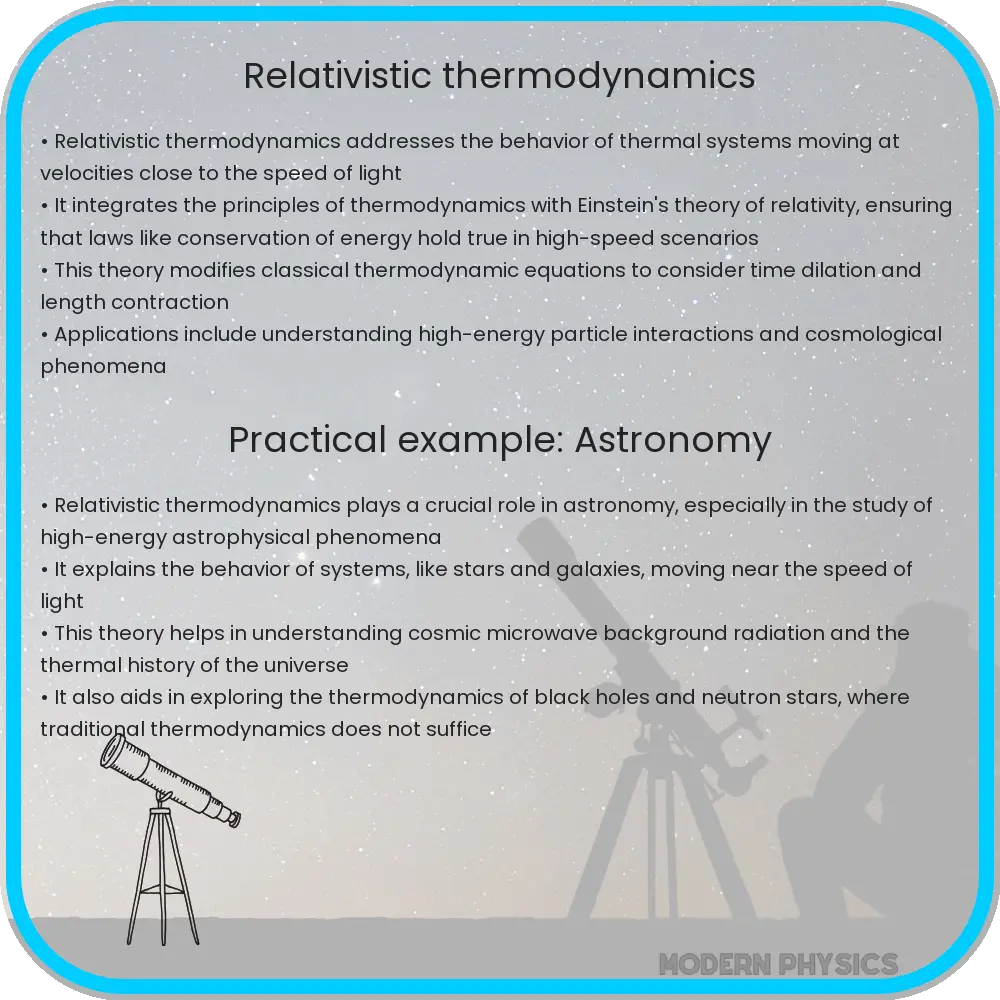Explore the intriguing world of Relativistic Thermodynamics, where heat, energy, and momentum dynamics merge with Einstein’s theory of relativity.

Understanding Relativistic Thermodynamics
Relativistic thermodynamics is a fascinating field that extends the laws of thermodynamics to systems moving at velocities comparable to the speed of light. This advanced field of study merges the principles of thermodynamics with Einstein’s theory of relativity, providing a comprehensive understanding of heat, energy, and momentum dynamics in high-speed systems.
The Basics of Relativistic Thermodynamics
At its core, relativistic thermodynamics deals with the behavior of systems in which thermal and mechanical processes occur at speeds approaching that of light. The necessity for this field arises from the fact that classical thermodynamics, based on Newtonian mechanics, fails to accurately describe phenomena at relativistic speeds. For instance, the traditional formula for kinetic energy, \( \frac{1}{2}mv^2 \), becomes inadequate at such high velocities.
In relativistic thermodynamics, the energy, momentum, and mass of a system are interrelated in a more complex manner than in classical thermodynamics. Einstein’s mass-energy equivalence principle, represented by the famous equation \( E = mc^2 \), where \( E \) is energy, \( m \) is mass, and \( c \) is the speed of light, plays a crucial role in this field. This principle implies that as a system’s velocity approaches the speed of light, its mass and energy increase significantly.
Key Concepts and Equations
One of the foundational equations in relativistic thermodynamics is the relativistic energy-momentum relation:
\[ E^2 = (pc)^2 + (mc^2)^2 \]
where \( E \) is the total energy, \( p \) is the momentum, \( m \) is the rest mass, and \( c \) is the speed of light. This equation demonstrates the deep connection between energy, mass, and momentum in relativistic contexts.
Another critical concept is the relativistic temperature transformation. It addresses how temperature, a fundamental thermodynamic quantity, transforms between reference frames moving relative to each other. This transformation is essential for understanding how heat flows in relativistic systems.
Moreover, relativistic thermodynamics also modifies the laws of thermodynamics. The first law, dealing with the conservation of energy, and the second law, concerning entropy, require adjustments to accommodate relativistic effects. These modifications ensure that the laws hold true even at high velocities, where relativistic effects are significant.
Applications and Implications of Relativistic Thermodynamics
Relativistic thermodynamics has profound implications in various scientific fields, particularly in astrophysics and particle physics. In astrophysics, this theory is crucial for understanding the behavior of stars and galaxies moving at high velocities. It also plays a significant role in studying phenomena like black holes and neutron stars, where gravitational fields are extremely strong, and relativistic effects are prominent.
In particle physics, relativistic thermodynamics is essential for describing the behavior of particles in accelerators, where they reach speeds close to the speed of light. This understanding is crucial for predicting the outcomes of high-energy particle collisions and for exploring fundamental questions about the nature of matter and energy.
Furthermore, the principles of relativistic thermodynamics are also instrumental in advancing our understanding of the early universe. During the first moments after the Big Bang, the universe was in a highly energetic and dense state, where relativistic effects were significant. Thus, applying relativistic thermodynamics helps in modeling and comprehending these early stages of the universe’s evolution.
Challenges and Future Directions
Despite its importance, relativistic thermodynamics is still an area with many unresolved questions and challenges. One of the primary challenges is integrating the principles of quantum mechanics with relativistic thermodynamics to develop a more comprehensive framework. This integration is essential for a deeper understanding of phenomena at both the cosmic and quantum scales.
Additionally, experimental verification of relativistic thermodynamic theories remains a significant challenge due to the extreme conditions required. Advances in technology and experimental techniques in the coming years are expected to provide more insights and validation for these theories.
Conclusion
In summary, relativistic thermodynamics is a critical field of study that extends the traditional laws of thermodynamics to high-speed, high-energy systems. Its applications in astrophysics, particle physics, and cosmology are pivotal for our understanding of the universe. While the integration with quantum mechanics and experimental verification pose challenges, the ongoing research in this field continues to enhance our knowledge and push the boundaries of what we know about the fundamental laws governing energy and matter. As technology advances, we can anticipate more groundbreaking discoveries and a deeper understanding of the universe through the lens of relativistic thermodynamics.
Is this conversation helpful so far?
